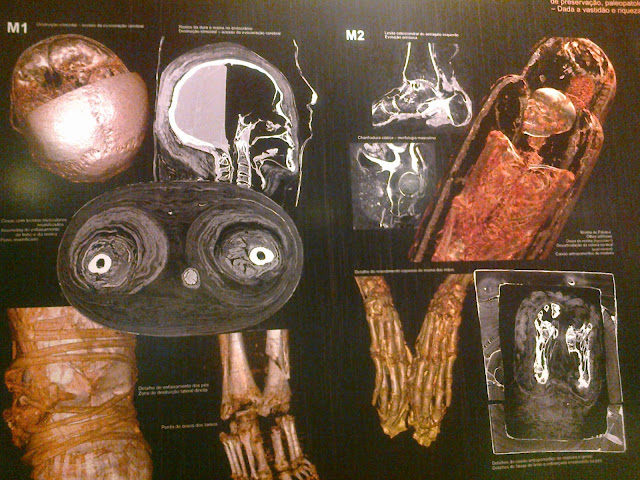A recent lecture in Lisboa showed the first results of this project, profusely explained by the imagiologist who supervised this scanning of human and animal mummies.
The Carmo Museum is housed within the ruins of a convent in downtown Lisboa:
http://museusportugal.org/aap/html/museu.htm
This lecture was part of a program which is happening yearly in which a Fair of Archaeology is presented to the public and some visits to archaeological sites are organized:
http://festadaarqueologia2012.wordpress.com/
The lecture started at 4,30pm with the Professor of Egyptology Luis Araujo. He gave some general introductory informations about sarcophagi and mummies, enhancing ancient Egyptian thoughts towards life and death.
Next, the Lisboa Mummy Project was presented by Dr. Prates, a specialist and experienced imagiologist, which has scanned the 3 human mummies and 7 or 8 (not sure) animal mummies from Egypt, part of the National Museum of Archaeology collection:
http://www.mnarqueologia-ipmuseus.pt/?a=3&x=2&cat=7
The three mummies are called respectively:
Irtieru
Pabasa
Orsuhet
About 120 000 images are now saved for future investigators and future projects; digital x-rays and CAT scan images, and the Radiological Atlas of the Collections in the National Museum of Antiquities at Leiden by Dr. Raven: http://www.rmo.nl/english/research/staff/curator-egypt was used as reference to identify and classify the mummies.
There are provisional conclusions to what might have been the cause of death/ action to cause death on the animals mummies; the ibis missing a vertebrae, to eviscerate the body, the crocodile with a luxation on a cervical vertebrae with incised wound.
About the human mummies there are also some provisional conclusions to what might not be arteriosclerosis, but a taphonomic thickening of the arteries, caused by the resins employed in mummification. The heart of two of the mummies was found but not at first glance of the scans, as the hearts are so shrinked they almost get unnoticed.
Dental abrasion, of course, as usual, artificial eyes on Pabasa, made of ceramic with an iris drawn and a spot in the middle.
Orsuhet is the 'youngest' mummy, dated from Ptolemaic times, and here we see the calcium deposits in his illiac bones and some vertebrae. This suggests, according to Dr. Prates, a presence of metastasis from a tumor originating in the prostate.
The article with all the data was published in the International Journal of Paleopathology, under the title "Prostate metastatic bone cancer in an Egyptian Ptolemaic mummy, a proposed radiological diagnosis":
http://www.sciencedirect.com/science/article/pii/S1879981711000271
Looking forward for more developments,
Paula Veiga
The Carmo Museum is housed within the ruins of a convent in downtown Lisboa:
http://museusportugal.org/aap/html/museu.htm
This lecture was part of a program which is happening yearly in which a Fair of Archaeology is presented to the public and some visits to archaeological sites are organized:
http://festadaarqueologia2012.wordpress.com/
The lecture started at 4,30pm with the Professor of Egyptology Luis Araujo. He gave some general introductory informations about sarcophagi and mummies, enhancing ancient Egyptian thoughts towards life and death.
Next, the Lisboa Mummy Project was presented by Dr. Prates, a specialist and experienced imagiologist, which has scanned the 3 human mummies and 7 or 8 (not sure) animal mummies from Egypt, part of the National Museum of Archaeology collection:
http://www.mnarqueologia-ipmuseus.pt/?a=3&x=2&cat=7
The three mummies are called respectively:
Irtieru
Pabasa
Orsuhet
About 120 000 images are now saved for future investigators and future projects; digital x-rays and CAT scan images, and the Radiological Atlas of the Collections in the National Museum of Antiquities at Leiden by Dr. Raven: http://www.rmo.nl/english/research/staff/curator-egypt was used as reference to identify and classify the mummies.
There are provisional conclusions to what might have been the cause of death/ action to cause death on the animals mummies; the ibis missing a vertebrae, to eviscerate the body, the crocodile with a luxation on a cervical vertebrae with incised wound.
About the human mummies there are also some provisional conclusions to what might not be arteriosclerosis, but a taphonomic thickening of the arteries, caused by the resins employed in mummification. The heart of two of the mummies was found but not at first glance of the scans, as the hearts are so shrinked they almost get unnoticed.
Dental abrasion, of course, as usual, artificial eyes on Pabasa, made of ceramic with an iris drawn and a spot in the middle.
Orsuhet is the 'youngest' mummy, dated from Ptolemaic times, and here we see the calcium deposits in his illiac bones and some vertebrae. This suggests, according to Dr. Prates, a presence of metastasis from a tumor originating in the prostate.
The article with all the data was published in the International Journal of Paleopathology, under the title "Prostate metastatic bone cancer in an Egyptian Ptolemaic mummy, a proposed radiological diagnosis":
http://www.sciencedirect.com/science/article/pii/S1879981711000271
Looking forward for more developments,
Paula Veiga


Sem comentários:
Enviar um comentário